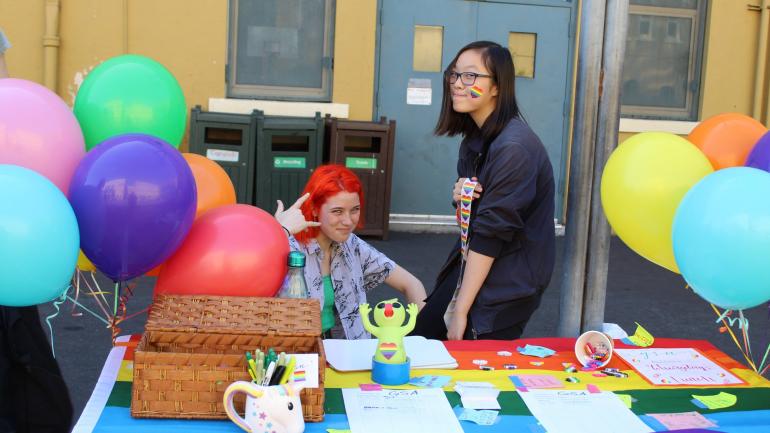
A commitment to public education that truly serves all students means not only ensuring kids have access to challenging classes and academic help, but that they have the support they need to be their best, most authentic selves both in and out of the classroom. That’s the goal of Gateway High’s Gender & Sexuality Alliance (GSA), an affirming club for students across the LGBTQ+* spectrum and allies alike to seek solidarity and make a positive impact on the greater Gateway High community.
“I joined last year because I think society tries to put a lot of restrictions on how we’re supposed to act if we’re a certain gender or certain race or whatever,” said Marjorie, a GHS senior. “Here you can be whatever you want to be, and nothing is holding you back.”
Gateway’s GSA is one of more than a thousand such student organizations in California, and has had a presence on campus for many years. It has grown in popularity over the past several years and today is one of the more active student groups on campus.
“I wanted to be a faculty advisor because I know my campus in high school would have benefited from a strong community of folks celebrating the rainbow of identities represented on campus,” said Anastasia Zamkinos, who teaches 9th grade humanities and serves as the GSA’s adult liaison with the school community. “In high school I certainly could have used the interpersonal support and sense of belonging that can come from a community of folks who shared this part of my identity, so I wanted to do my part to support students and staff in creating that sense of support, belonging, and community with one another.”
While San Francisco has earned a reputation for being an inclusive and diverse community, and LGBTQ+ issues are firmly in the American mainstream, GSA students say there is still much work to be done on campus, in the Bay Area, and nationally.
“When I was a freshman, I didn’t think LGBT acceptance was a big deal, but as I’ve progressed I’ve noticed people still have a lot of misconceptions and stereotypes about the LGBT community,” said GHS senior Carina. “So I decided to re-invest myself in the GSA and take more of a leadership position, hopefully to help build a more inclusive and accepting environment.”
To that end, the GSA organizes a mix of different events and activities to engage the student body, like movie nights and open mic events. The club’s most ambitious venture this year is a clothing drive to benefit queer and trans homeless youth, some of San Francisco’s most vulnerable young people.
Gateway staff also take steps to ensure their classrooms are spaces where all students feel respected and able to take risks. Surveying students on their preferred pronouns early in the year, weaving LGBTQ+ voices and content into the curriculum, and displaying supportive art in the classroom are small steps many faculty take to foster an inclusive school culture. Many faculty also participate in the GLSEN Day of Silence in April along with the GSA, taking “a vow of silence to highlight the silencing and erasure of LGBTQ people at school.” Teachers may choose to teach in silence for all or part of each class, and staff and students participate in a ceremonial “breaking the silence” in the garden after the school day ends.
“Many of us are, ourselves, LGBTQIA+,” said Anastasia. “Having adults in the building who are out can help students feel like they're not alone and like they have folks they can talk to.”
Interested community members can support the GSA through contributing to the upcoming clothing drive. Clean clothes in good condition can be left in a bag or box labeled "Ms. Zamkinos/GSA" in the main office or directly in Room 101. For more information about supporting GSA events and fundraisers, email Anastasia directly.
*In the interest of honoring the voice of our sources for the article, you will notice different variations of the LGBTQ+ acronym throughout, reflecting their preferred use of the term. More information on the language used to describe the gender and sexuality spectrums can be found in this excellent resource from the NY Times.